Chapter 15: Taste (Gustation)
1/40
Earn XP
Description and Tags
Perceiving Tastes and Flavors
Name | Mastery | Learn | Test | Matching | Spaced |
|---|
No study sessions yet.
41 Terms
What is flavor a combination of?
Taste + olfaction = flavor
Texture
Sound (hearing a crunch)
Temperature (some things are better warm)
Color (used to things being certain colors)
Presentation: vision
Smell (shared oral and nasal cavity)
Shape of the food
Environment:
Atmosphere and humidity
Social situations, culture
Personal connection
Your health, past experiences
What is gustation?
Taste perception
Where are the taste buds?
Inside the papillae on the tongue
What are the 5 well-established taste categories?
Sweet
Salty
Umami (savory)
Sour
Bitter
What is a tastant?
A molecule that taste receptors “recognize” and respond to.
They then send signals to the brain
What is hedonics?
Pleasant and unpleasant sensations
What is chemothesis?
Burn-like sensation from spices
Cool like sensation from menthol
Tingling from carbonated drinks
What is the trigeminal sense?
“Mouth feel” of food.
Detects possible irritants
About two-thirds of the taste buds are found on the..
TONGUE
What are papillae?
Tiny structures on the surface of the mouth, mainly on the tongue.
How many types of papillae are there that contain taste buds?
THREE
How many types of papillae are there? (Whether they contain taste buds or not?)
FOUR
How many types of taste receptor cells (TRCs) are there?
TWO
receptor cells
contains receptors that inititiate transduction of sweet, umami, and bitter tastants
presynaptic cells
Receptors take the form of ion channels where transduction of salty and sour tastants is initiated
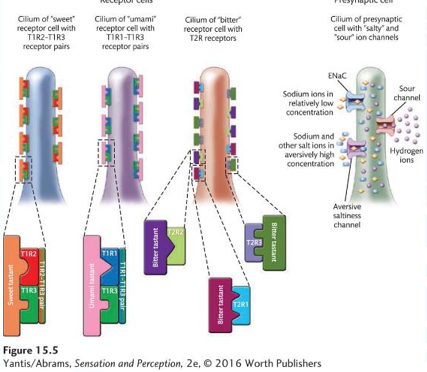
What are taste receptor receptor cells?
Elongated neurons that contain taste buds and transduce tastants into neural signals
What do the papillae look like?
They are the tiny bumps on your tongue
Where are the taste receptor cells located?
In the taste buds
Which on on the sides of the papillae
What three forms of papillae contain taste buds
1.) Fungiform
2.) Foliate
3.) Circumvallate
The taste buds that detect bitter, salty, sour, etc. Are there areas on the tongue where clusters of the same receptors respond to the same taste? If so, where?
NO
All taste buds are random throughout. No ryme or reason
What does the circumvallate papillae detect the best?
Bitterness
While all are random, circumvallate papillae are found near the back.
These bumps are bigger than the rest
What papillae does not contain taste buds?
Filiform
What is the use of the filiform papillae?
This helps in manipulating food on the tongue.
This covers much of the tongue’s surface
What do receptor cells transduce?
Sweet
Umami
Bitter
What do presynaptic cells trasnduce?
Salty tastants
Sour tastants
There are four receptor cells that identify the __ main tastants.
FIVE (5)
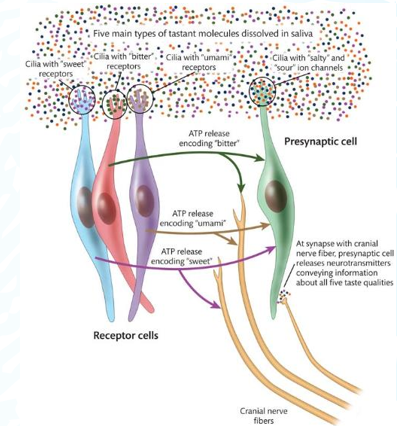
There are two theories about how the information leaves the tongue. What does science suggest is the reason and which one does science say evidence points to?
Across-fiber pattern: Suggests that the cranial nerve fibers are responsible for information from several tastes.
Differences in taste quality based on the relative activity of the different types of receptors.
What cranial nerves are responsible for carrying taste signals to the brain?
7 (facial), 9, 10 (vagus nerve)
They all end up in the medulla (solitary track nucleus) - thalamus - gustatory cortex
What is the process from taste receptors to the brain?
1.) Taste receptors
2.) Cranial nerve
3.) Nucleus of the solitary track (midbrain)
4.) Ventral posterior medial nucleus (thalamus)
5.) Primary taste cortex
anterior insular cortex
Frontal operculum
6.) Amygdala
6.) Orbitofrontal cortex
6.) Hypothalamus
What does the orbitofrontal cortex have to do with food?
This is the representation of reward in food.
Taste quality (Primary taste cortex) is still being used, but this has nothing to do with the acceptance of the food.
What does this mean? Is this the brain telling us to move on to find new nutrients?
Meal prepping. You lose the want to have something if you have it a lot. Don’t buy things in bulk? Mix up your dinner schedules?
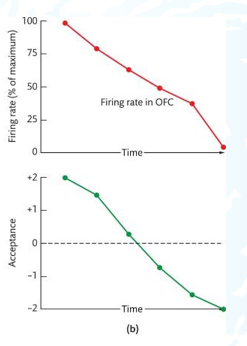
What does the primary taste cortex represent?
Taste quality of foods
What does the amygdala have to do with food?
This is the representation of emotion tied with our food.
What is the hypothalamus responsible for?
Feeding
Fighting
Fleeing
Mating
What is adaption?
Taste sensitivity is reduced after continuous exposure
EX: A lot of salty food and you will eventually lose sensitivity to salty foods. It won’t be as strong.
__ can influence our response to food.
Hint: this is perception
EXPECTATIONS!
People think that $90 wine tastes better than $10 wine even if they are the same drink. The graph talks about initial reactions.
This is working on the orbitofrontal cortex (reward center). Cost truly matters.
What is sensory-specific satiety?
This is a reduction in appetite specifically for foods that have been recently consumed.
Encouraging you to have different tastes
“Always room for dessert.”
Think about holiday eating. Many different foods. You might eat more than normal because of the broad range of foods available.
Would a desire for a specific food occur in the absence of a sense of taste?
YES!!
Our bodies is telling us that something is nutrious even when we can’t taste. Mice who had no taste receptors, gravitated toward the sugar water rather than the plain water over time.
What does it mean when something has no caloric content as it relates to artificial sweeteners?
They aren’t metabolized.
Which artificial sweetener is metabolized and only needs small amounts to be detectable?
Aspartame.
What is capsaicinoids?
Spice!
Spice isn’t a flavor. It is pain and is activating your heat receptors.
__ is not fulfilled with artificial sweetners
Satiety
You don’t get satiated, you are going to look elsewhere. Those who consume artificial sweeteners have more of a correlation for a higher intake of calories.
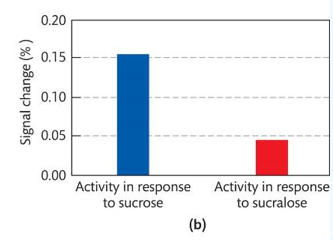
What does this mean?
Natural sweeteners have more of a reaction than artificial. The left graph is the natural. Their needs are being met. They are less likely to seek other nutrients to fulfill that need.
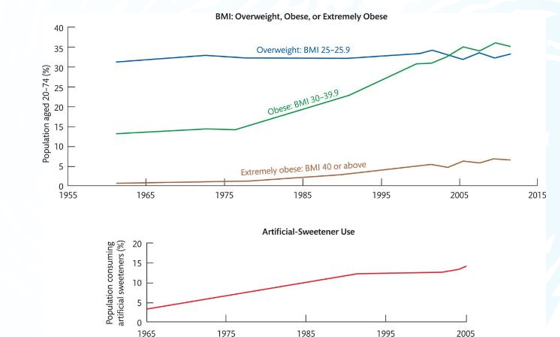
What does this graph mean?
That there might be a correlation between the increase of artificial sweeteners and obesity.